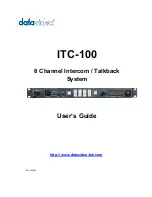
About This Manual
DAQCard E Series User Manual
xii
National Instruments Corporation
•
Appendix B,
Optional Cable Connector Descriptions
, describes the
connectors on the optional cables for the DAQCard E Series cards.
•
Appendix C,
PC Card Questions and Answers
, contains a list of
common questions and answers relating to PC Card operation.
•
Appendix D,
Common Questions
, contains a list of commonly asked
questions and their answers relating to usage and special features
of your DAQCard E Series card.
•
Appendix E,
Power-Management Modes
, describes the power
management modes of the DAQCard E Series cards.
•
Appendix F,
Customer Communication
, contains forms you can use
to request help from National Instruments or to comment on our
products.
•
The
Glossary
contains an alphabetical list and description of terms
used in this manual, including acronyms, abbreviations, metric
prefixes, mnemonics, and symbols.
•
The
Index
alphabetically lists topics covered in this manual,
including the page where you can find the topic.
Conventions Used in This Manual
The following conventions are used in this manual.
♦
The
♦
indicates that the text following it applies only to specific
DAQCard E Series boards.
< >
Angle brackets containing numbers separated by an ellipsis represent a
range of values associated with a bit, port, or signal name (for example,
ACH<0..7> stands for ACH0 through ACH7).
bold
Bold text denotes parameters, menus, menu items, dialog box buttons
or options, and error messages.
bold italic
Bold italic text denotes a note, caution, or warning.
italic
Italic text denotes emphasis on a specific DAQCard in the
DAQCard E Series or on other important information, a cross reference,
or an introduction to a key concept.
monospace
Text in this font denotes text or characters that are to be literally input
from the keyboard, sections of code, programming examples, and
syntax examples. This font is also used for the proper names of disk
drives, paths, directories, programs, subprograms, subroutines, device












































